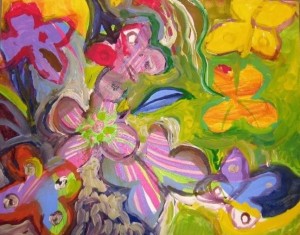The HEAL Foundation has utilized The Cummer’s galleries, gardens, and experience working with children with disabilities for 19 years and counting. This is part two of a three part series highlighting the benefits art can provide children with autism.
Art can play an important role in the lives of many children, teens, and adults diagnosed with Autism Spectrum Disorder. It can be therapeutic, and gives the individual with autism an avenue of creativity and self-expression. The activity of art can quell many of the stimulatory behaviors caused by the disorder and be a soothing and calming exercise for the participant. Since many young children with autism have deficiencies in their gross and fine motor skills and are adverse to learning new things, teachers and parents should explore the options art offers as a therapeutic tool.
Very Special Arts
Once “The Rainbow Artists” became a success, the Executive Director of HEAL, Scottie May, and I visited Hope McMath, Director of the Cummer Museum of Art and Gardens to inquire if they too would be interested in hosting camps for students with autism. The Cummer Museum had experience working with children with disabilities, hosting an annual event each spring called the “Very Special Arts” Festival (VSA). The Cummer Museum’s VSA program – a nationally recognized event designed specifically for school children with disabilities–spans over a three-day period hosting nearly 3,000 ESE students. The students are bused from four surrounding counties and spend an educational afternoon of art at the museum.
There are eight art stations meandering all through the stately museum and out into the beautiful gardens situated along the scenic St. Johns River. Live music with guitar and drum ensembles fills the air and musicians invite the children to join in. The students visit each station, engaging with volunteers to create art projects including many different art mediums from sculpting to watercolor painting in the gardens.
Through the VSA, The Cummer Museum director and staff had experience working with special needs children, but at the time did not offer a specific art class or camp for children with autism. After hearing the success of the MOCA autism art program, Hope McMath and her staff welcomed the opportunity to offer art camps for students with autism. HEAL awarded The Cummer a grant to get the art camp classes going and they continue to be a great success.
The Butterfly Project
By 2009, both MOCA Jacksonville and The Cummer Museum of Art and Gardens were gaining recognition for their superb work in hosting camps for kids with autism. Carol Lombardo and I brainstormed on many ideas to create a HEAL art project to get the students’ art into the public arena so we could share the successes we were seeing. We decided to bridge the museums together with an art project which could also raise money for the art programs. By exhibiting and auctioning off the art created by the students, we could generate money to off-set the costs of the camps. This would also allow the students to exhibit their art in our community, making them proud of their accomplishments.
Within the HEAL logo is a butterfly which signifies change, joy, love and metamorphosis, something we hope for our children with autism. Using the butterfly theme, we created “The Butterfly Project: art interpretations of the butterfly” to encourage collaborations between noted local artists and the students who attended the art camps. Small teams of students were paired up with artists to create their interpretation of the butterfly. The outcomes were amazing: some of the paintings were abstract, some full of vivid color–one in particular had the handprints of the children within the butterfly—and all were stunning and beautiful.
The Butterfly Project turned out fourteen paintings which “migrated” across Jacksonville to different venues for residents of the city to see. Months later, the butterfly paintings eventually made their way to the TPC Sawgrass Club in Ponte Vedra Beach, to be auctioned at The HEAL Foundation’s “Valley of Dreams” gala. Thousands of dollars were raised through silent auctions which were invested back into MOCA and Cummer museums via grants from HEAL for continued support of their autism art programs.
Stay tuned for Healing Through the Arts: Part III, coming soon!



